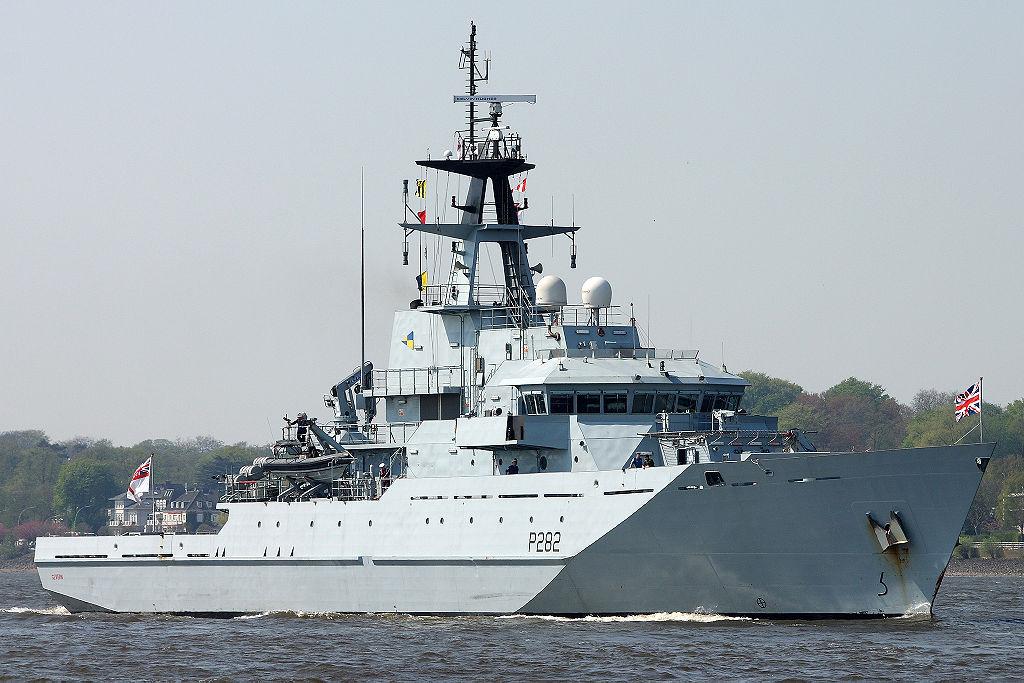 The first batch of three River-class OPVs (HMS Tyne, Severn and Mersey) were ordered for the Royal Navy in April of 2001, built in Southampton, and commissioned in the second half of 2003. A fourth, slightly larger vessel (HMS Clyde) was built in Portsmouth and commissioned in 2007 for patrol duties around the Falkland Islands. In October of 2014, barely eleven years after the HMS Tyne was delivered, steel was cut in Glasgow for the first of three new River-class vessels. Surprisingly, they’re expected to replace the first three by 2017–18.
The first batch of three River-class OPVs (HMS Tyne, Severn and Mersey) were ordered for the Royal Navy in April of 2001, built in Southampton, and commissioned in the second half of 2003. A fourth, slightly larger vessel (HMS Clyde) was built in Portsmouth and commissioned in 2007 for patrol duties around the Falkland Islands. In October of 2014, barely eleven years after the HMS Tyne was delivered, steel was cut in Glasgow for the first of three new River-class vessels. Surprisingly, they’re expected to replace the first three by 2017–18.
Fifteen years is a short service life for large patrol vessel. It was indeed a brief history of (HMS) Tyne. The Royal Navy’s preceding patrol boats, the Island-class and Castle-class were in commission for 28 and 26 years respectively. Additionally, the UK government announced in the 2015 Strategic Defence and Security Review (PDF) that it would purchase a further two River-class OPVs, bringing the total fleet to six.
The rational Strategist reader might at this point be wondering why the UK is paying for five boats to replace three boats that arguably aren’t old enough to require replacement anyway. The answer is that block-building of the HMS Prince of Wales aircraft carrier ended in 2014 and construction of the Type-26 Frigates was due to begin in 2016. A Terms of Business agreement signed between the UK government, the MoD and BAE Systems in July 2009 guaranteed 15 years of work with a minimum expenditure of £230 million per year, on the grounds that ‘[t]his level of work was independently verified as the minimum level of work possible to sustain a credible warship building industry in the UK’.
In the absence of new ships to build during this time, the MoD decided to build three new River-class OPVs to retain shipbuilding skills and to justify the inescapable annual expense. The date for approval of the Type 26 to proceed to production (though not necessarily for the cutting of steel) has since been delayed to 2017 or later. Lo and behold, the Royal Navy will be getting two more River-class vessels. Even that doesn’t seem to be enough to avoid some serious pain for all involved, with promises to Scottish shipyards and uncertainty about the number of shipyard jobs causing the same sorts of political ructions we’ve experienced here in Australia.
An argument put forward is that the OPVs are ‘cheap’. Here’s what the UK Secretary of State for Defence had to say in 2013:
‘The marginal cost of these ships, over and above the payments the MOD would anyway have had to make to keep the yards idle, is less than £100 million…’
Well, OK, but the RN now has to crew and support them throughout their lives, with all of the future opportunity costs that will accrue. If you don’t actually need them, ‘cheap’ vessels can be expensive.
Since Australia is about to embark on continuous build strategy ourselves, it’s worth understanding how this all came to pass, to see what we might learn from the UK’s unhappy situation. The trouble is that it’s hard to see how we can avoid the same pitfalls. Once a continuous build is signed off, there’s a big political capital outlay and any future government will find it difficult to step away from the arrangement. Even if there are good reasons to do so, angry unions and state politicians will make sure that there’s little chance of economic or strategic rationalism carrying the day.
The construction of the River-class OPVs is only the latest example of shipyard continuity distorting decision making in the UK. An earlier example was when serious thought was being given to cancelling the second of the Queen Elizabeth-class aircraft carriers. The 2010 Strategic Defence and Security Review (PDF) left the fate of the second vessel to be decided in 2015. But the deliberations didn’t take long, and completion of the second carrier was confirmed only a few months later, based on a curious mix of sunk cost reasoning (over £3 billion had been spent by then), short term financial impact (while there would be a net saving, the immediate cancellation costs would hit in the current financial year) and a perceived need to provide continuous work for the naval shipbuilding sector. The MOD explained that it had
‘…to take into consideration the wider impact on the UK warship industry. Put simply, if one or both of the carriers were cancelled, and if the Government wished to retain a UK capability for the design and manufacture of complex warships, then alternative replacement work would need to be found.’
The rational approach in this situation, or the ‘valley of death’ caused by slippage of Type 26 design work, is to work out the costs of stopping and restarting and compare it to the cost of confecting work. But once you lock in a guaranteed line of work, especially if you reinforce it with guaranteed payments, it’s hard to even have that conversation.